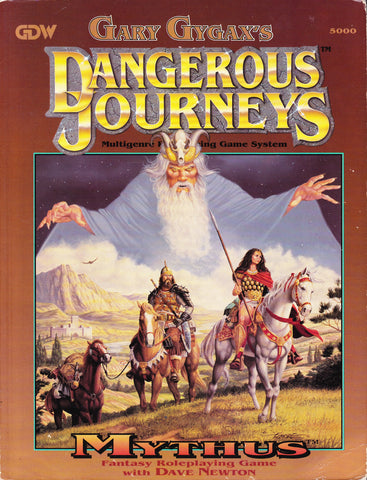Looking through Dangerous Journeys is indeed dangerous!
Share


I have to wonder what the minds of Frank Chadwick, Marc Miller, and Rich Banner thought when Gary Gygax agreed to put out a new RPG under the Game Designer’s Workshop banner? I’m sure that was a great deal of ecstasy there, a feeling that after doing this job since 1973 that they ‘gold ticket’ had finally been found.
Yet as any old school gamer knows, the release of Gygax’s Dangerous Journeys in 1992 was the incendiary fuel for the folding of the GDW just four years later, with the epitaph ‘Everybody was just really happy to move on’ being uttered by Miller years later.
Was Dangerous Journeys the direct cause of the collapse? Perhaps not completely, as Magic the Gathering and the contraction of the market as a whole had a part to play, but certainly Dangerous Journeys became a loadstone no mid-range company could keep afloat.
With TSR all over the games creation in legal wars that eventually halted production after seven books, the cost of which will never be fully known. To make matters worse, the game itself was a rules heavy monster that was the antithesis of Gygax’s style with Dungeons & Dragons, a seeming odd choice considering his adherence to that streamlined rules set, but perhaps it was needed to fully differentiate between systems [although it obviously didn’t matter to TSR].
Whatever the case, the core rulebook, Mythus, was something that found its way into my gaming collection in 1992 as I worked my way through university. It was during this period that I found out the older brother of my friend Mark, who was the catalyst for getting us both into role-playing, was taking classes to finish a degree as well. Greg, the older brother, and diehard Gygax loyalist, was sure to play the new system, and so I was able to take part in one ill-fated campaign before Dangerous Journeys became a permanent piece of my past.
Today, as always, I’m going to revisit the artwork from this 413 page book. Like most large core books of this time period, artist Larry Elmore did the cover. The now freelance Elmore was a sure bet to ‘sell copy’ by having him do the cover, although unlike his Shadowrun treatment for FASA, this one seemingly failed. In the case of Mythus, he still brought some of his TSR talent with him, however there is a divergence from his usual standard. The two key factors in this are the ‘Dungeon Master, Manipulating Wizard, or Sky Druid’ that overpowers the upper part of the frame. It takes a page from Jeff Easley’s redux of the classic 1E AD&D DM’s Guide, although unlike that it simply fails to inspire anything in the viewer other than a sense of ‘huh…’. I can only attribute this to poor art direction from co-ADs, Steve Bryant and Amy Doubet.
The second infraction is Elmore’s choice of female cover model. Now it is clear that during Elmore’s TSR run of dominance he established a very standard heroine that was uniquely Elmore. By 1992, he’d moved away from this all-encompassing female muse to a living model driven style and for that I think this cover suffers. His female fighter might be different, but sometimes different does not translate to better.
Still, we find the usual Elmore suspects, mailed fighter, strong horse, and dramatic landscape, but the absence of a dragon is puzzling here, especially since Dangerous Journeys was initially coined Dangerous Dimensions [to be another D&D] before legal action killed that, so maybe GDW was also forbade from putting a dragon on the cover.
Inside, the artwork is perhaps even less inspired. A rag-tag team of artists have put together hundreds of black and white images and even a few color plates for the book, but on the whole the art is sub-par. There are standouts, certainly, with a handful of pieces by TSR alum Tony Szczudlo, a two page spread of oriental theme by Janet Aulisio that is to die for, and some color plates that carry a hint of what Lee Moyer would become, even if the bulk of the work was shared by Moyer with Darrell Midgette. These pieces, no matter how they might shine, cannot hold the others above water and therefor are more an oddity that makes one wonder what could have been instead of inspiring a player to take part in a deep and dynamic setting.
In all, this product is unexciting, non-innovative, and haphazardly directed.
Artistic Rating: 2 [out of 5]

